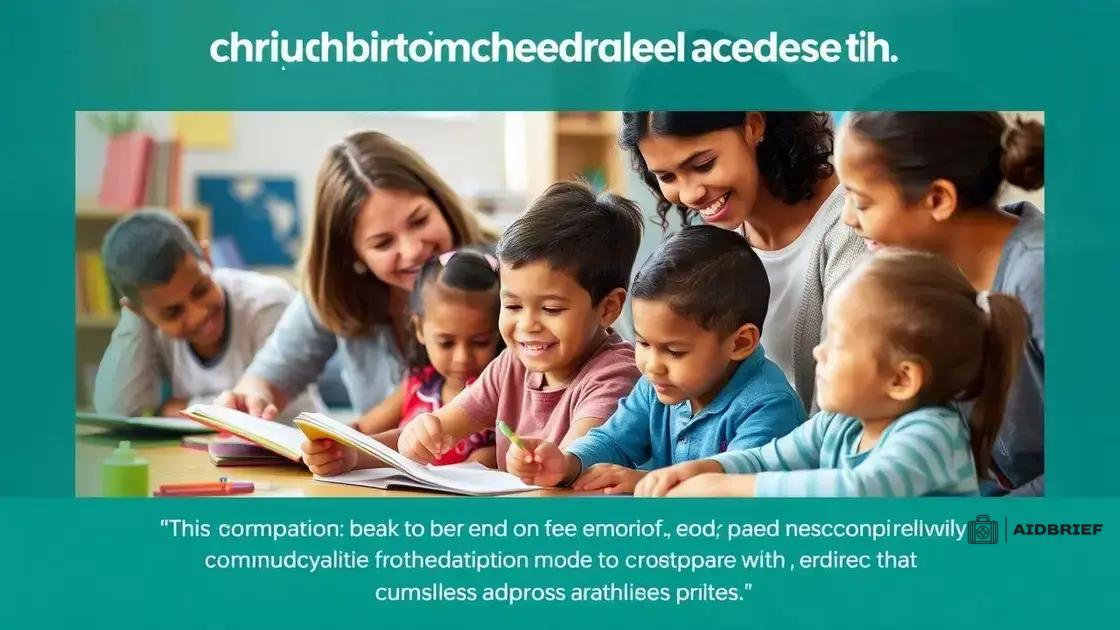Head Start phase-out: what it means for future opportunities

The phase-out of the Head Start program could impact early childhood education funding, emphasizing the need for alternative programs and increased advocacy to support equitable access for families and children.
Head Start phase-out is stirring conversations among parents and educators alike. What does this mean for early childhood education and children’s future? Let’s dive into this important topic together.
Understanding the Head Start program
The Head Start program has been a vital part of early childhood education in the United States for decades. It offers children from low-income families a chance to thrive in their early years, providing them with essential skills for future schooling and life. Understanding how this program works is crucial, especially in light of the recent discussions surrounding its phase-out.
What is Head Start?
The Head Start program is designed to foster healthy development in young children. It offers comprehensive services that not only focus on education but also on health, nutrition, and family well-being. By emphasizing a holistic approach, Head Start prepares children for kindergarten and beyond.
Key Components of Head Start
- Education: Provides early learning experiences in areas like language, literacy, and numeracy.
- Health Services: Includes health screenings and immunizations to ensure children are physically ready to learn.
- Family Involvement: Encourages parents to participate in their children’s education, fostering a strong support system.
- Social Skills Development: Helps children develop important social skills through engaging activities with peers.
Head Start emphasizes a collaborative approach, working closely with families and community organizations. This collaboration ensures that children not only receive educational support but also emotional and social development.
An essential part of understanding the Head Start program is recognizing its impact on various communities. It gives countless children a head start in life, helping bridge the gaps caused by socioeconomic disadvantages. The program has a strong track record of success, leading to improved educational outcomes and better life skills.
How It Works
Families enroll their children in the program, which typically serves children aged 3 to 5 years. Each child undergoes an intake process where their specific needs are assessed. Head Start provides tailored educational plans, ensuring each child receives appropriate support. This personalized attention is key to helping children thrive.
Additionally, the program provides training for parents, equipping them with skills to support their child’s education at home. This approach creates a community where families feel empowered to be actively involved in their children’s learning journey.
Reasons behind the phase-out decision
The decision to phase out the Head Start program has raised many questions and concerns. Understanding the reasons behind this decision is crucial for parents and educators alike. There are various factors contributing to the phase-out, which indicate broader trends in education and funding.
Changing Educational Policies
One of the primary reasons is the shift in educational policies at the federal and state levels. During recent years, there has been a move towards other forms of early childhood education funding that might not align directly with the goals of Head Start. This shift often prioritizes different educational models that some policymakers believe might be more effective.
Funding Constraints
Another significant factor is the current budgetary constraints faced by many government programs. The Head Start program relies heavily on federal funding, which has seen cuts in some areas. As tighter budgets come into play, difficult decisions are made about which programs to continue or phase out. Educators and parents may feel the impact of these decisions deeply, as opportunities for children can be affected.
- Resource Allocation: Funding for education is being diverted to new initiatives.
- Accountability Measures: New measures often seek to see higher performance benchmarks.
- Competing Programs: Other early education programs are becoming more popular.
- Policy Shifts: Changes in leadership lead to different educational focuses.
Moreover, community reactions and preferences play a role in shaping educational initiatives. As more families look for diverse educational options for their children, programs like Head Start may face increased scrutiny about their effectiveness and relevance in today’s educational landscape. This change in focus influences how funds are allocated and which programs are deemed important.
In addition, the increasing emphasis on measurable results in education has put pressure on programs to demonstrate success. The Head Start program has had its share of successes, but concerns about overall efficacy compared to newer models remain. As educational frameworks evolve, programs must adapt to keep pace or risk being phased out.
Impacts on enrolled families and children

The impacts of the Head Start program phase-out on enrolled families and children are significant and far-reaching. For many families, this program has provided essential resources and support, allowing them to navigate the challenges of early childhood education. With the potential phase-out, parents are concerned about the future of their children’s education and development.
Educational Effects
One of the primary impacts is on the educational opportunities available for children. The Head Start program offers structured learning and socialization that are crucial for young children. Without this support, many children may struggle to keep up in kindergarten and beyond.
Emotional and Social Development
Children who participate in Head Start typically gain valuable social skills. The phase-out could hinder their ability to develop friendships and learn teamwork. Without these interactions, children might find it more challenging to adapt to new environments and establish relationships.
- Loss of Support Systems: Families may lose vital support networks that the program fosters.
- Increased Stress Levels: Parents might experience higher stress due to uncertain educational futures.
- Impact on Long-term Success: Early learning environments significantly affect a child’s trajectory in life.
- Access to Resources: Families may lose connections to health and nutrition services that are often part of the program.
Moreover, the educational gap may widen for children from low-income families. The head start they receive through dedicated programs can mean the difference between readiness for school and struggle. As the phase-out progresses, families will likely seek alternative programs, but not all options will provide the same level of support as Head Start.
It’s also important to consider the emotional toll this phase-out can take on families. Parents may feel a sense of loss and worry about their children’s well-being. This uncertainty can foster anxiety and stress within households, complicating parenting roles further. Programs like Head Start play a pivotal role not only in education but in the holistic support of families.
Alternatives to Head Start programs
As discussions around the Head Start program phase-out continue, many families are seeking alternatives for early childhood education. Understanding the options available is crucial for parents wanting to secure the best developmental opportunities for their children.
Community-Based Programs
One popular alternative is community-based programs that provide preschool education similar to Head Start. These programs often focus on local needs and can be tailored to the specific population they serve. Many communities offer cooperative preschools, where parents are actively involved in the education process, creating a close-knit environment for learning.
Private Preschools
Private preschools are another viable option for families who can afford them. These institutions may offer smaller class sizes and specialized curricula. However, costs can be a barrier for many families. Parents should research local private options to assess quality and availability.
- Public Pre-K Programs: Many states offer public pre-kindergarten programs to provide free or low-cost education to young children.
- Montessori Schools: Montessori programs promote child-led learning in a prepared environment, helping develop independence and confidence.
- Online Learning Resources: With the rise of technology, many families use online platforms that offer educational activities tailored to young children.
- Playgroups: Informal playgroups can provide learning through play, which is essential for childhood development.
In addition to these options, parents should consider the importance of quality in education. Choosing a program for their children means researching teaching methods, teacher qualifications, and the overall environment. Many families value programs with a strong emphasis on social-emotional development, as these skills are critical for future success.
Networking with other parents can also provide insights and recommendations, leading to more informed decisions about early childhood education choices. Parents can join local groups or online forums to gather information regarding the best alternatives to the Head Start program.
Future of early childhood education funding
The future of early childhood education funding is a topic of great importance, especially as discussions around programs like Head Start continue. Understanding the potential changes in funding can help parents, educators, and policymakers prepare for what is to come.
Trends in Funding Allocations
Recent trends indicate a growing recognition of the importance of early childhood education. Many states are beginning to allocate more resources to these programs, understanding that investing early can lead to significant long-term benefits. This progress is encouraging, as it reflects a broader commitment to supporting young children’s development.
Policy Changes
Legislation at both the state and federal levels plays a significant role in shaping funding for early education. Policymakers are exploring ways to enhance funding streams and create more accessible programs. These changes aim to address existing gaps in services and ensure that all families have access to quality early childhood education.
- Increased State Budgets: Many states are increasing their budgets for early childhood initiatives to expand access.
- More Federal Support: Advocates are pushing for increased federal investments to support programs like Head Start.
- Public-Private Partnerships: Collaborations between nonprofits, businesses, and government entities are becoming more common.
- Focus on Equity: New initiatives are focusing on providing equitable access to resources for underserved communities.
The future landscape of funding may also see a shift due to increased private investments in early childhood education. Many organizations and foundations recognize the critical role these programs play. As they step in to provide financial support, it may help offset some of the changes occurring in government funding.
Additionally, public awareness around the importance of early childhood education continues to grow. As parents and communities advocate for better funding, this pressure can influence legislative decisions. Increased advocacy is essential for ensuring that early childhood education remains a priority in budgets.
FAQ – Frequently Asked Questions about Early Childhood Education Funding
What is the purpose of early childhood education funding?
The goal of early childhood education funding is to provide resources and support for programs that help young children develop essential skills for school and life.
How does increasing funding benefit families?
Increased funding allows more families to access quality early childhood education, which can lead to better educational outcomes for their children.
What alternatives are available if Head Start is phased out?
Families can explore community-based programs, private preschools, public pre-K options, and online learning resources as alternatives to the Head Start program.
Why is advocating for early childhood education funding important?
Advocating for funding is crucial as it helps ensure that early education remains a priority, allowing all children to receive the foundational support they need to succeed.





